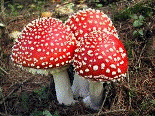Gut Function Initiative

Heather Hallen-Adams Publications
Document Type
Article
Date of this Version
11-2007
Citation
PNAS, November 27, 2007, vol. 104, no. 48, 19097–19101; doi: 10.1073/pnas.0707340104
Abstract
Amatoxins, the lethal constituents of poisonous mushrooms in the genus Amanita, are bicyclic octapeptides. Two genes in A. bisporigera, AMA1 and PHA1, directly encode α-amanitin, an amatoxin, and the related bicyclic heptapeptide phallacidin, a phallotoxin, indicating that these compounds are synthesized on ribosomes and not by nonribosomal peptide synthetases. α-Amanitin and phallacidin are synthesized as proproteins of 35 and 34 amino acids, respectively, from which they are predicted to be cleaved by a prolyl oligopeptidase. AMA1 and PHA1 are present in other toxic species of Amanita section Phalloidae but are absent from nontoxic species in other sections. The genomes of A. bisporigera and A. phalloides contain multiple sequences related to AMA1 and PHA1. The predicted protein products of this family of genes are characterized by a hypervariable ‘‘toxin’’ region capable of encoding a wide variety of peptides of 7–10 amino acids flanked by conserved sequences. Our results suggest that these fungi have a broad capacity to synthesize cyclic peptides on ribosomes.


Comments
This article is a U.S. government work, and is not subject to copyright in the United States.